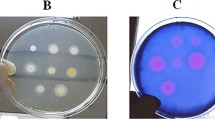Abstract
The incidence of methicillin-resistant Staphylococcus aureus (MRSA) infections after middle ear surgery has recently increased at our hospital. Most of these infections were thought to be hospital-acquired when medical personnel in contact with an MRSA-infected patient may have inadvertently transmitted the pathogen to other patients. To prevent further transmission it is essential that such sources of MRSA infection and transmission routes be selected out and eradicated. Therefore, it is necessary to determine whether the strains of MRSA isolated from infected patients are identical to those obtained from medical personnel in order to prove a reciprocal transmission of organisms between medical personnel and patients. Surveillance bacterial cultures from the anterior nares and hands of medical personnel working in the Department of Otolaryngology, Korea University Guro Hospital, were performed at two different time points: 6 December 1994 and 17 June 1996. Ribotyping with Southern blot technique was used to compare 12 MRSA strains from medical carriers with 60 strains identified from the otorrhea of MRSA-infected patients undergoing middle ear surgery. As result, six different MRSA strains were identified (types I, II, III, IV, V and VI) from ribotyping with EcoR1. One distinct subtype, type I strain, was the most frequently identified strain in both medical carriers and patients. Results also showed that 6 MRSA isolates from 10 medical carriers and 20 from 30 patients contained type I ribotype at first culture. Two medical carriers’ isolates and 13 isolates from 30 patients shared the same type I strain at the second surveillance culture. In all, 41 out of 72 MRSA strains (56.9%) shared an identical ribotype pattern. Postoperative MRSA infection rates after treatment of medical carriers and the application of rigorous preventive procedures decreased from 11.9 to 5.7% after first culture and 9.0 to 7.7% following second cultures. These findings confirm that MRSA transmission can occur between medical personnel and patients and that effective preventive measures can reduce the postoperative infection rate.
Similar content being viewed by others
Author information
Authors and Affiliations
Additional information
Received: 24 June 1997 / Accepted: 19 February 1998
Rights and permissions
About this article
Cite this article
Suh, H., Jeon, Y., Song, J. et al. A molecular epidemiologic study of methicillin-resistant Staphylococcus aureus infection in patients undergoing middle ear surgery. European Archives of Oto-Rhino-Laryngology 255, 347–351 (1998). https://doi.org/10.1007/s004050050074
Issue Date:
DOI: https://doi.org/10.1007/s004050050074




